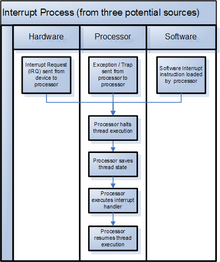Interrupt
An interrupt is when something happens to a microprocessor that causes it to interrupt the currently running code to allow it to respond to the thing that happened. Interrupts usually occur because the processor gets a special signal from hardware, but they can also be caused by software. Many things can cause interrupts, including pressing keys on a keyboard, moving the mouse, the built-in timer going off, a data transfer taking place, or an event that was triggered which needs attention from the processor right away. Interrupts can happen at any time, no matter what program is running or where in the program's source code it is.

How interrupts work
changeThe purpose of an interrupt is to temporarily pause normal code execution to allow the processor to respond very quickly to the thing causing the interrupt. Once that thing has been dealt with, the processor can resume the work it was doing.
An interrupt is triggered by a hardware or software call known as an interrupt request (IRQ). When an IRQ happens, the processor immediately stores the details of what it is doing on a stack for safe keeping, and then beings to follow special instructions to respond to the interrupt. These instructions form a very short program called an interrupt handler or interrupt service routine (ISR). The ISR must be short so the processor can get back to its original work as fast as possible. As soon as the ISR is completed, the processor goes back to the stack where it stored the context of its original work on a stack, and resumes running code exactly where it left off.
Many interrupt controllers in today's processors use an interrupt vector as a way to sort interrupts based on where they came from or how important they are. The vector contains the special programs (ISRs) that will run when each different interrupt happens. ISRs are generally responsible for dealing with, or "servicing", the interrupt, along with keeping itself in good working order. [1]
Uses of interrupts
change| Use case | Practical example |
|---|---|
| Triggering tasks at regular intervals | Blinking a light every time a 5-second timer expires |
| Servicing an external device | Collecting a measurement from a sensor every time the sensor says a new measurement is ready |
| Triggering the operating system to take action | Reacting to a USB flash drive getting plugged into the computer |
| Increasing power efficiency | Instead of software constantly checking whether something has happened (which wastes electricity), the code can be designed differently to just wait for an interrupt to occur. |
References
change- ↑ Massey, Russell (June 1, 2001). "Introduction to interrupts". Embedded.